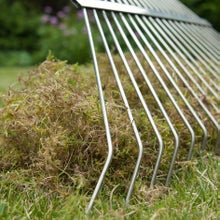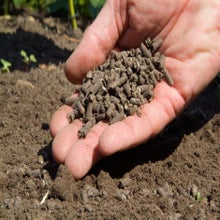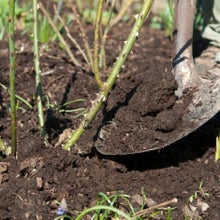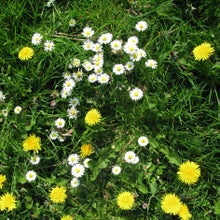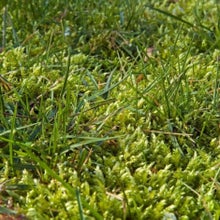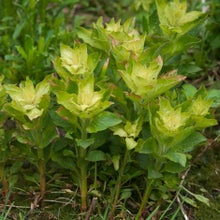
Quick facts
Regular lawn care will help to keep your grass strong and resilient
Drought is a common cause of brown patches in summer
Several fungal diseases can weaken or kill grass
Dog urine can damage patches of lawn
Over application or incorrect use of fertilisers and weedkillers can damage or kill turf
What causes dead patches?
There are many potential reasons why bare patches may appear, from physical damage to fungal diseases and drought. It can be tricky to diagnose just by appearance, so instead it’s best to consider which causes may apply to your lawn. Below we outline the most common causes of dead patches and how to remedy them.
Regular lawn care can help to avoid patchy grass – see our guides for more advice:
Drought and soil issues
1) Irregular brown patches during dry weather – especially where tree roots run under the lawn or in areas where the soil is sandy and drains quickly
Cause: Lack of moisture in the soil
Remedy: This is usually a temporary problem and dead grass will recover once rain returns. Also see our advice on lawn care during drought
2) Irregular brown patches on new lawns
Cause: Buried builders’ waste or rubble, or soil compaction due to heavy machinery
Remedy: Remove the buried material or remedy the compacted soil, then re-seed or re-lay the affected areas of lawn
Lawn-care issues
1)Regular brown stripes or patches that appear after feeding the lawn
Cause: An overdose of fertiliser
Remedy: Always follow the dosage instruction on the packet carefully – using too much can not only harm the environment, it can also scorch the plants you are trying to help. Consider whether it is really necessary to feed your lawn. If you do decide to feed, take care to apply the correct dose evenly. If using a mechanical distributor, calibrate it carefully before use. Ideally, apply fertiliser before rain, or water after feeding if no rain is forecast. Controlled-release lawn fertilisers may be less likely to cause scorch. See the following guides for more advice on fertiliser use:
2)Regular stripes or patches that appear after applying weedkiller or mosskiller
Cause: An overdose of lawn weedkiller or mosskiller. Alternatively, if you have used a weedkiller nearby, it can be carried onto the lawn on footwear and appear as footprint-sized dead patches
Remedy: Avoid using weedkillers; consider removing weeds by hand or using other non-chemical control methods, or opt for a species rich lawn. If you do use a weedkiller, always follow the instructions on the packaging. See the following guides for more advice:
3)Dead patches on raised areas of uneven lawn after mowing
Cause: Cutting raised areas too short, which can weaken or kill the grass
Remedy: Adjust the cutting height of your mower to avoid scalping the grass – see our guide to mowing for advice on this. Level out bumps and dips in your lawn to ensure a more even cut – see our guide to repairing lawns for how to do this, along with how to repair the bare areas
4) Irregular random patches that appear after mowing
Cause: Spilt petrol and oil can kill grass
Remedy: Avoid topping up fuel or checking oil levels on your mower when it’s on the lawn, and be careful not to overfill the fuel tank or exceed the recommended oil levels. Fuel may also spill out when tipping up a mower to check or unclog the blades. To repair the damaged patches, see our guide to repairing lawns
Animal and insect problems
1) Dead patches that spread rapidly, often in conjunction with birds pecking the lawn surface
Cause: This suggests that insects are feeding on the grass roots
Remedy:Leatherjackets and chafer grubs are the most likely culprits
2) Circular patches with bright green margins on lawns that dogs have access to
Cause: Dog urine – particularly female dog urine – can damage grass
Remedy: Water the affected areas immediately. Before feeding your dog any products that claim to prevent damage, consult your vet
Fungal diseases
1)Dead or discoloured patches that spread rapidly, often during damp weather
Cause: Fungal diseases and moulds mainly strike in wet weather, particularly in late summer, autumn and winter
Remedy: See the following advice pages on common lawn diseases: lawn rust, red thread, fusarium patch or snow mould, fairy rings, take-all patch and slime moulds on lawns
2) Dark green followed by brown patches with no recovery after rain
Cause: These are a bit of a mystery, but the presence of water-repellent fungi appears to be a major factor
Remedy: Rewetting the soil, although this can be tricky – see our advice on dry patch
